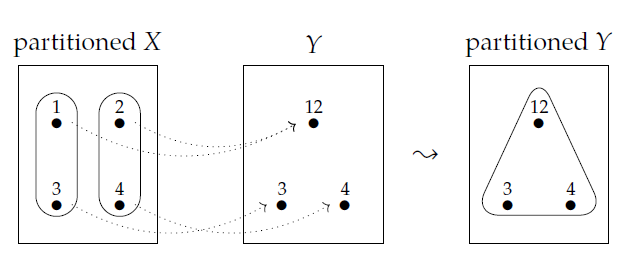 |
 |
Lecture 14 - Adjoints, Joins and Meets
I've spent four lectures on the logic of partitions; you may be wondering why. One reason was to give you examples illustrating this important fact:
Theorem. Left adjoints preserve joins and right adjoints preserve meets. Suppose \(f : A \to B\) and \(g : B \to A\) are monotone functions between posets. Suppose that \(f\) is the left adjoint of \(g\), or equivalently, \(g\) is the right adjoint of \(f\). If the join of \(a,a' \in A\) exists then so does the join of \(f(a), f(a') \in B\), and
[ f(a \vee a') = f(a) \vee f(a'). ]
If the meet of \(b,b' \in B\) exists then so does the meet of \(g(b), g(b') \in A\), and
[ g(b \wedge b') = g(b) \wedge g(b'). ]
The proof is very easy, so this deserves being called a "Theorem" only because it's so fundamental! I will prove it later, in more generality. Right now let's see how it's relevant to what we've been doing.
In Lecture 9 we saw something interesting about the subsets. Given any set \(X\) there's a poset \(P(X)\) consisting of all subsets of \(X\). Given any function \(f : X \to Y\) there's a monotone map
[ f^* : P(Y) \to P(X) ]
sending any subset of \(Y\) to its preimage under \(f\). And we saw that \( f^{\ast} \) has both a left adjoint and a right adjoint. This means that \( f^{\ast} \) is both a right adjoint and a left adjoint. (Remember: having a left adjoint means being a right adjoint, and vice versa.)
So by our Theorem, we see that \(f^* : P(Y) \to P(X)\) preserves both meets and joins! You can also see this directly - see Puzzle 41 in Lecture 13. But what matters here is the general pattern.
In Lecture 13 we also saw something interesting about partitions. Given any set \(X\) there's a poset \( \mathcal{E}(X)\) consisting of all partitions of \(X\). Given any function \(f : X \to Y\) there's a monotone map
[ f^* : \mathcal{E}(Y) \to \mathcal{E}(X) ]
sending any partition of \(Y\) to its pullback along \(f\). And we saw that while \( f^{\ast} \) preserves meets, it does not preserve joins!
So by our Theorem, we see that \(f^* : \mathcal{E}(Y) \to \mathcal{E}(X)\) cannot be a left adjoint. On the other hand, it might be a right adjoint.
And indeed it is! So, this strange difference between the logic of subsets and the logic of partitions is really all about adjoints.
Puzzle 42. Given a function \(f : X \to Y\) there is a way to push forward any partition \(P\) on \(X\) and get a partition \(f_{!} (P)\) on \(Y\). In pictures it looks like this:

although this is not the most exciting example, since here \(f_{!}(P)\) has just one part. Figure out the precise general description of \(f_{!} (P)\). If you get stuck read Section 1.5.2 of Seven Sketches.
Puzzle 43. Show that for any function \(f : X \to Y\), pushing forward partitions along \(f\) gives a monotone map
[ f_{!} : \mathcal{E}(X) \to \mathcal{E}(Y) . ]
Puzzle 44. Show that for any function \(f : X \to Y\), \(f^* : \mathcal{E}(Y) \to \mathcal{E}(X)\) is the right adjoint of \(f_{!}: \mathcal{E}(X) \to \mathcal{E}(Y)\).
To read other lectures go here.
 |
 |